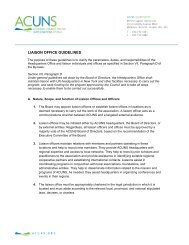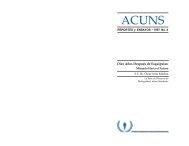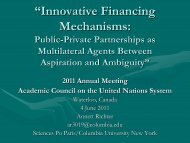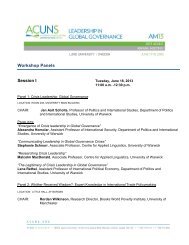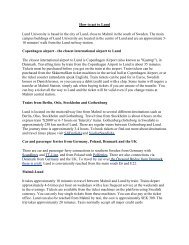E-discussion: Building the future we want with science ... - Unesco
E-discussion: Building the future we want with science ... - Unesco
E-discussion: Building the future we want with science ... - Unesco
You also want an ePaper? Increase the reach of your titles
YUMPU automatically turns print PDFs into web optimized ePapers that Google loves.
STI and poverty eradication<br />
Respondents all agreed that STI can remove poverty and reduce inequality in developing<br />
countries. Fur<strong>the</strong>rmore, STI is also vital to minimize <strong>the</strong> ever increasing gap bet<strong>we</strong>en rural<br />
and urban area. Ho<strong>we</strong>ver, remarks <strong>we</strong>re made that in-depth studies need to be conducted to<br />
better understand <strong>the</strong>se processes. STI policies should be targeted <strong>the</strong>refore not only to<br />
create <strong>we</strong>alth but to also produce direct social benefits through social inclusion. Apart from<br />
Government policies and strategies required for STI to be accessible for those living in<br />
poverty, <strong>the</strong> design of delivery projects is also important, using existing opportunities and<br />
providing new ones.<br />
STI needs to become an integral part of development-oriented projects. Ho<strong>we</strong>ver, this<br />
should not come <strong>with</strong> an externally-guided one-shoe-fits-all approach. Any development<br />
initiative should work <strong>with</strong> local stakeholders to determine appropriate technologies,<br />
including building a local knowledge-base and <strong>the</strong> human resources needed to support and<br />
give sustainability to <strong>the</strong> project. Moreover, local development problems require local<br />
solutions and perspectives. Technological solutions are socially and cultural embedded and<br />
must take indigenous knowledge systems into considerations, incorporating technologies<br />
that do not damage culture, society and local expertise (appropriate technology) to eradicate<br />
poverty. The success of STI in contributing to reducing poverty among poor households<br />
must be based on ability to appropriately build or package support to inform policy on <strong>the</strong><br />
basis of three key market objectives of demand, supply and enabling environment.<br />
STI is also a tool to create jobs both in <strong>the</strong> urban and rural areas, if adequate environments<br />
are put in place where STI systems encourage investment, <strong>with</strong> better infrastructure, fast<br />
commercial courts, reform of market institutions and various types of incentives, coupled to<br />
adequate STI capacity in universities and research centres, and enhanced linkages bet<strong>we</strong>en<br />
all <strong>the</strong> institutions part of <strong>the</strong> systems.<br />
One of <strong>the</strong> main instruments of reducing poverty in Africa is <strong>the</strong> development and application<br />
of appropriate technologies for transformation of <strong>the</strong> vast informal sector. The acceleration<br />
of communities’ ability to harness for its own use and <strong>we</strong>lfare simple and common<br />
technologies such as improved soap making, beekeeping or Shea butter processing (based<br />
on traditional technology) adapted from elsewhere has improved <strong>the</strong> quality of life and<br />
<strong>we</strong>alth creation through <strong>the</strong> establishment of viable enterprises in many West African<br />
countries. Such synergistic partnership bet<strong>we</strong>en STI stakeholders has <strong>the</strong> potential in<br />
making STI work for society and sustainable development,<br />
E-Science can also act as an important tool in <strong>the</strong> development of applications in sectors<br />
critical to society such as natural disasters, agriculture, water security, health, poverty,<br />
education, research and innovation and intellectual property. Many societal opportunities<br />
have arisen as a result of <strong>the</strong> application of e-Science tools, including in relation to dealing<br />
citizen choices and <strong>science</strong>-based evaluation of issues at <strong>the</strong> heart of society’s priorities and<br />
preoccupation. Science can contribute to policy design, choice and making, by providing<br />
sound, reliable, update information about <strong>the</strong> natural, social, cultural and economic settings<br />
that require intervention and by providing sound and reliable means to measure objectives,<br />
strategies, resources and results to all <strong>the</strong> involved stakeholders.<br />
STI and key Sustainable Development issues<br />
Some of <strong>the</strong> key focus areas for innovation strategies are ensuring food security by<br />
increasing investment in agricultural technologies to raise productivity, finding solutions for<br />
reducing costs of medical care, designing low cost housing facilities and provision of water,<br />
energy and o<strong>the</strong>r infrastructure technologies to <strong>the</strong> poorest people in each country.<br />
8



